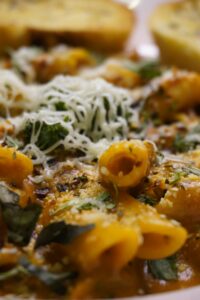Italian cuisine is one of the most celebrated and widely accepted culinary cultures in the globe. Fresh, aromatic, and deeply connected with rich cultural heritage, Italian cuisine is not just a dish, but an experience that brings people together. From the simplicity of Margherita pizza to the elegance of a well-prepared risotto, Italian cuisine has something to offer to all.
A Gourmet Tour of Italy
Italian cuisine is as diverse as Italy’s divisions. Each region of Italy has its own specialized cuisine and cooking methods, diverse in terms of location, climate, and history.
Northern Italy: Northern Italian cuisine is known for thick polentas, hearty risottos, and meat dishes, and rice, butter, and cheese are employed in abundance. Milan welcomes the world to its famous Risotto alla Milanese, and Venice is renowned for its seafood risotto.
Central Italy: Central Italy is home to some of Italy’s best-known dishes, including Rome’s carbonara spaghetti and Tuscany’s Florentine steak (bistecca alla Fiorentina). Olive oil, tomatoes, and herbs are fundamental to central Italian cuisine.
Southern Italy: Birthplace of Pizza, Southern Italy is home to strong flavors, hot sauces, and heavy reliance on tomatoes, olives, and seafood. The region is renowned for neapolitan pizza, pasta alla Norma, and calamari fritti, among the most celebrated of regional dishes.

Principal Ingredients of Italian Cuisine
Italian cuisine is based on fresh, quality ingredients. Some of the most important ingredients are:
Olive oil: Italian pantries stock extra virgin olive oil to sauté, dress a salad, and serve over bread.
Tomatoes: In endless sauces, soups, and stews, tomatoes add the characteristic tangy sweetness to Italian cuisine.
Pasta: With more than 350 different forms, pasta is probably Italy’s most adaptable food, each of which is perfectly suited to a particular sauce.
Cheese: From Parmigiano-Reggiano to Mozzarella di Bufala, Italian cheese is rich and intense.
Spices and herbs: The use of oregano, rosemary, basil, and garlic is necessary for the addition of fresh, aromatic flavor.

Classic Italian Recipes
Pizza Margherita: Basic but classic recipe using fresh tomato sauce, mozzarella, basil, and olive oil.
Pasta Carbonara: Creamy Roman pasta with eggs, Pecorino cheese, pancetta, and black pepper.
Lasagna: Layers of pasta, meat sauce, béchamel, and cheese baked golden brown.
Tiramisu: Classic Italian dessert made from ladyfingers soaked in coffee, mascarpone cheese, and cocoa powder.

The Italian Dining Experience In Italy, dinner time is spent with family members and friends bonding over good food and company. Italian meals tend to be eaten in courses, starting with antipasti (appetizers), followed by primo (pasta or soup), secondo (meat or fish), contorno (vegetable dish), and ending with dolce (sweet dish). Italian cuisine is not merely food, it‘s tradition, it’s culture, it’s the passion for life. Whatever you are doing, having a piece of pizza in Naples or newly prepared pasta in a small village in Tuscany, with every bite, it’s a tale of tradition and passion.



